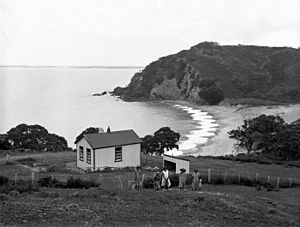Whatuwhiwhi facts for kids
Quick facts for kids
Whatuwhiwhi
|
|
|---|---|

Tokerau Beach, looking towards Whatuwhiwhi
|
|
| Country | New Zealand |
| Region | Northland Region |
| District | Far North District |
| Ward | Te Hiku |
| Community | Te Hiku |
| Subdivision | Whatuwhiwhi |
| Electorates |
|
| Area | |
| • Total | 6.66 km2 (2.57 sq mi) |
| Population
(June 2023)
|
|
| • Total | 590 |
| • Density | 88.6/km2 (229.4/sq mi) |
Whatuwhiwhi or Karikari is a small community. It is located at the northern end of Tokerau Beach. This area is part of the Karikari Peninsula in Northland, New Zealand. To the south, you'll find Doubtless Bay.
The town of Kaitaia is about 39 kilometers away. Whatuwhiwhi has three beautiful sandy coves. These coves offer safe swimming. However, they are not ideal for anchoring boats because they are open to strong winds from the south-east.
Contents
A Glimpse into History
First European Visitors
In 1769, a French explorer named Jean-François-Marie de Surville arrived in the area. His ship, the St Jean Baptiste, entered Doubtless Bay. This was just eight days after Captain James Cook had named the bay.
De Surville and his crew anchored near Rangiawhia Pa. This was just north-east of Whatuwhiwhi. They arrived on December 17, 1769. The crew gathered fresh plants from the shore. On Christmas Day, Father Paul-Antoine Léonard de Villefeix held the first Christian church service in New Zealand waters.
A Storm and Its Aftermath
A big storm hit on December 27. Some of de Surville's men were stuck on shore at Whatuwhiwhi. The local Māori people treated them kindly. During the same storm, the ship's anchors broke free. The crew had to cut them loose. The ship's small boat, called a yawl, also hit rocks and was cut free.
After the storm, the stranded men returned to the ship. On December 31, the yawl was seen on Tokerau Beach. Māori people were gathered around it. De Surville sent an armed group to get it back. They met a group of Māori carrying spears. The chief, Ranginui, approached de Surville. He carried a twig of green leaves, a sign of peace.
However, de Surville arrested Ranginui. He believed Ranginui had stolen his boat. De Surville's group then burned about 30 huts. They also destroyed one canoe and took another. They brought Ranginui back to their ship. The crew members who had been stranded identified Ranginui. They said he was the chief who had been kind to them. But de Surville kept Ranginui captive. The St Jean Baptiste then sailed for Peru. Ranginui sadly died 12 weeks later from a disease called scurvy.
Remembering the Past
In 1969, a special plaque was put up at Whatuwhiwhi. It remembers de Surville's visit. The anchors that were left behind during the storm were found. They were brought up from the sea in 1974. This was a big effort by the community.
About the People of Whatuwhiwhi
Population and Homes
Whatuwhiwhi is considered a rural community. It covers about 6.66 square kilometers. In the 2023 New Zealand census, 696 people lived here. This was a big increase of 201 people since the 2018 census. There were 342 males and 351 females. They lived in 264 homes. The average age of people in Whatuwhiwhi was 49.4 years.
Diverse Backgrounds
People in Whatuwhiwhi come from many different backgrounds.
- About 62.5% identified as European (Pākehā).
- About 58.2% identified as Māori.
- Smaller groups included Pasifika (6.5%) and Asian (1.3%).
English is spoken by most people (97.4%). The Māori language is also spoken by 19.8% of the community.
Education and Work
Many adults in Whatuwhiwhi have completed higher education. About 9.5% have a bachelor's degree or higher. Over half (55.6%) have a post-high school certificate or diploma.
The median income in Whatuwhiwhi was $27,100. This is lower than the national average. About 32.8% of people aged 15 and over worked full-time. Another 11.6% worked part-time.
Education in Whatuwhiwhi
Early Schools
Rangiawhia Native School opened in Whatuwhiwhi on January 27, 1902. Wiremu Taua was the head teacher until 1919. This was a special experiment. It was one of the first times a Native School had Māori staff. Wiremu Taua was the first Māori person to become a head teacher. The school became known for being excellent. This led to more Māori head teachers being appointed in other native schools. New buildings were added to the school in 1906. It usually had about 20 students. This school is no longer open.
Te Kura Kaupapa Māori o Rangiawhia was another school here. It was a primary school for years 1-8. It taught entirely in the Māori language. This school closed at the end of 2016.


